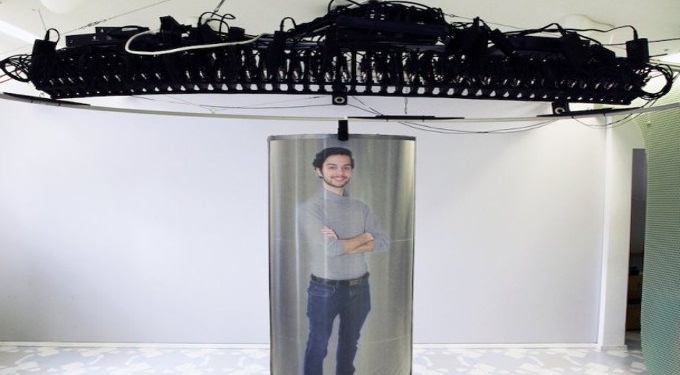
Credit: Human Media Lab
Source: Science Daily
A Queen's University researcher will soon unveil TeleHuman 2 — the world's first truly holographic videoconferencing system. TeleHuman2 allows people in different locations to appear before one another in life-size 3D — as if they were in the same room.
“People often think of holograms as the posthumous Tupac Shakur performance at Coachella 2012,” says Roel Vertegaal, Professor of Human-Computer Interaction at the Queen's University School of Computing. “Tupac's image, however, was not a hologram but a Pepper Ghost: A two-dimensional video projected on a flat piece of glass. With TeleHuman 2, we're bringing actual holograms to life.”
Using a ring of intelligent projectors mounted above and around a retro-reflective, human-sized cylindrical pod, Dr. Vertegaal's team has been able to project objects as light fields that can be walked around and viewed from all sides simultaneously by multiple users — much like Star Trek's famed, fictional ‘holodeck'. Capturing the remote 3D image with an array of depth cameras, his team has ‘teleported' live, 3D images of a human from one room to another — a feat that is set to revolutionize human telepresence. Because the display projects a light field with many images, one for every degree of angle, users need not wear a headset or 3D glasses to experience each other in augmented reality.
“Face-to-face interaction transfers an immense amount of non-verbal information,” says Dr. Vertegaal, who is also the head of the Queen's Human Media Lab. “This information is lost in online tools, promoting poor online behaviors. Users miss the proxemics, gestures, facial expressions, and eye contact that bring nuance, emotional connotation and ultimately empathy to a conversation. TeleHuman 2 injects these missing elements into long-distance conversations with a realism that cannot be achieved with a Skype or Facetime video chat.”
Dr. Vertegaal first debuted the TeleHuman technology in 2012, but at that time the device only allowed for a single viewer to see the holographic projection correctly. With TeleHuman 2, multiple participants are able to see their holographic friend or colleague, each from their individual perspective. To test the system, Dr. Vertegaal had users judge angles at which a robotic arrow, mounted on a tripod, was pointing whilst physically present in the room, and whilst rendered on the TeleHuman 2. They did not judge the angles between the real and the virtual representation as significantly different.
















